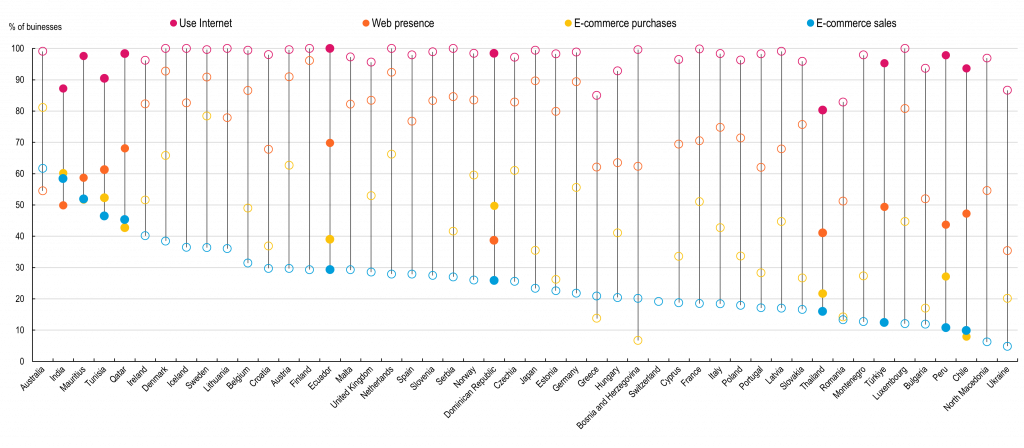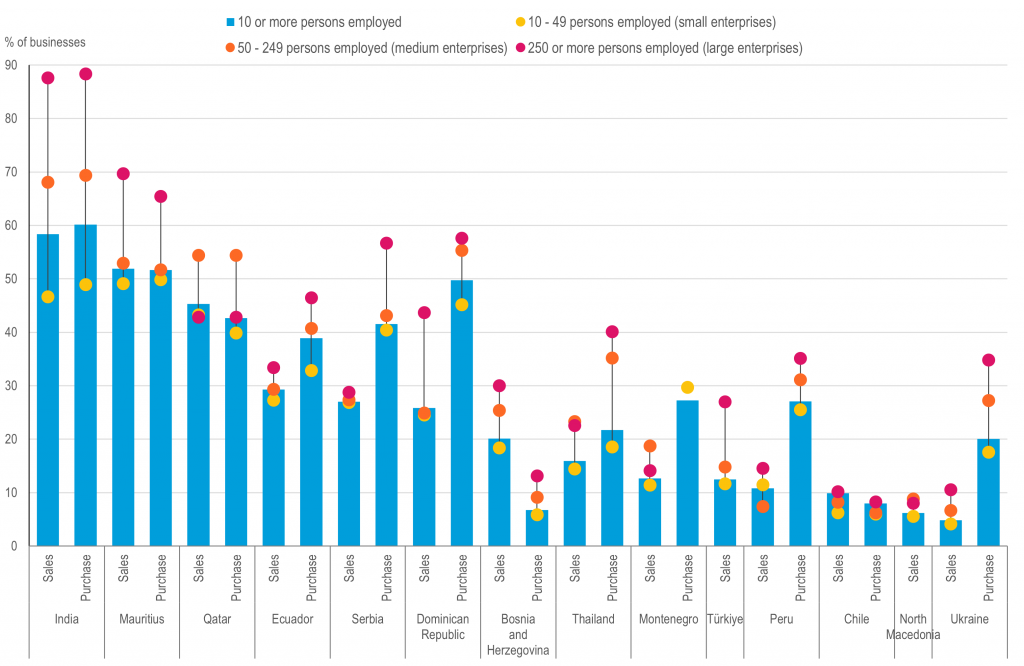Countries without these statistics face barriers in implementing the policies needed to support businesses in adapting to and benefiting from digital tools and technologies.
© Andrey_Popov/Shutterstock
As the COVID-19 pandemic has accelerated digital transformation, measuring how businesses are harnessing digital opportunities for economic resilience and sustainable development has become ever more critical.
To support policymakers, UNCTAD’s statistics database has updated the organization’s indicators on the use of information and communications technologies (ICT) by businesses, providing data until 2021.
The indicators, established through the Partnership on Measuring ICT for Development, are collected by UNCTAD from national statistical offices and complemented by data published by Eurostat.
They provide insights on the extent to which businesses in different countries are adopting digital technologies.
Among the countries providing data, over 80% of businesses have internet connection (95% on average across these countries). Businesses in different countries vary in the extent to which they use the internet to access customer and supplier markets (Figure 1).
On average, across these countries, 68% of businesses have a web presence such as a website or pages on a social network or online marketplace, the data shows.
The share of companies engaging in e-commerce is generally lower, with around 40% of businesses making online purchases from suppliers, while only 25% of businesses sell their products online.
“As the world becomes more digitally dependent, disparities that put individuals and businesses in developing countries at a disadvantage threaten to accelerate existing inequalities,” said Shamika N. Sirimanne, director of UNCTAD’s technology and logistics division.
“More decisive action is needed to bridge the widening digital and data divides,” she added.
Data collection in developing countries
Developing countries generally have the lowest rates of businesses selling online because due to challenges in adopting e-commerce and a lower share of people shopping online in these nations.
But several developing countries feature among those with the highest rates of businesses selling online, according to the data.
This may be due to differences in countries’ survey methods and coverage, indicating the need for more efforts to promote international comparability in business ICT statistics.
Figure 1: Business internet usage, 2021 or latest
(In order of share of businesses making e-commerce sales)
Source: UNCTAD based on core indicators of ICT use in business.
Notes: For each country and variable, if 2021 data is not available the latest available observation (2018 or later) is used. For e-commerce sales and web presence, the most common reporting year is 2021. For internet use it’s 2019, for e-commerce purchases it’s 2018. Data for India represents manufacturing only and the year 2018. Get information on the classification of developed and developing countries.
UNCTAD’s data provides breakdowns by businesses in urban or rural areas, industry classification and firm size.
Figure 2 shows that, in most countries, large enterprises – those with 250 or more employees – are most likely to engage in e-commerce.
But this is not always the case. In Montenegro, North Macedonia, Qatar and Thailand, medium-sized enterprises lead in e-commerce adoption.
Figure 2. Businesses making online sales or purchases, selected countries, 2021 or latest
Source: UNCTAD based on core indicators of ICT use in business.
Notes: Countries selected on the basis of developing country status and/or on the basis of being an UNCTAD member while not being a member of other organizations involved in international collections of business ICT data (Eurostat/OECD). Get information on the classification of developed and developing countries.
For each country and variable, if 2021 data is not available, the latest available observation (2018 or later) is used. Data for India represents manufacturing only and the year 2018.
These figures illustrate developing countries’ differing experiences in digital transformation.
They also show that only a few developing countries, and none of the least developed countries (LDCs), regularly collect data on these indicators and report them to international organizations such as UNCTAD.
Building capacity for digital transformation
UNCTAD’s indicators on ICT use by businesses provide a baseline for policymakers to monitor and manage their economies’ digital transformation.
The inclusion of countries’ indicators on the database fosters mutual learning and support, as all countries face challenges and impacts of digitalization.
UNCTAD provides the following capacity-building initiatives to help countries measure the digital economy and promote the harmonization of statistical methods to ensure comparability across countries:
- The UNCTAD Working Group on Measuring E-commerce and the Digital Economy, which will meet on 28 and 29 November 2022 to advance cooperation to enhance the availability, quality, comparability and relevance of statistics on e-commerce and the digital economy across countries.
- Capacity-building and support to national statistical agencies seeking to measure business ICT usage as well as e-commerce and digital trade. This includes statistical guidelines set out in the Manual for the Production of Statistics on the Digital Economy and training offered through UNCTAD’s Train for Trade platform.
- Help in sourcing financial and expert support for digital economy statistics from development partners.



